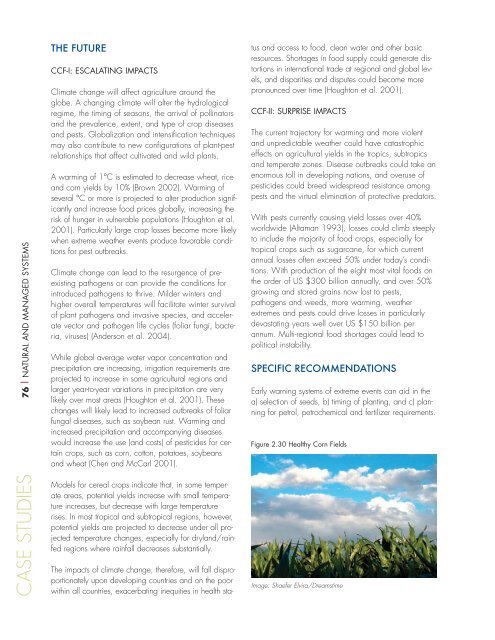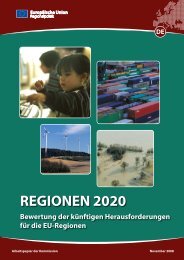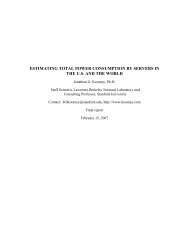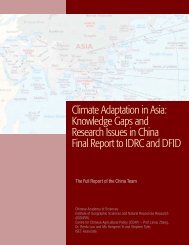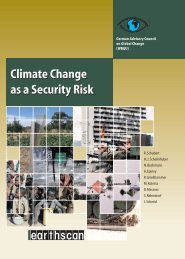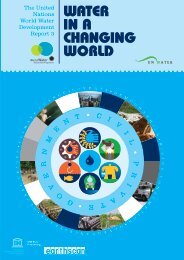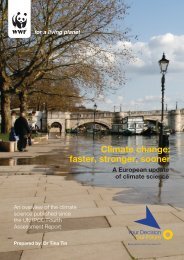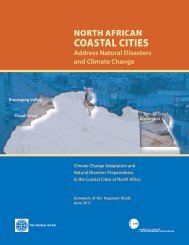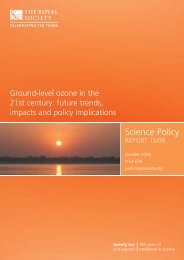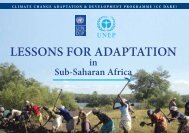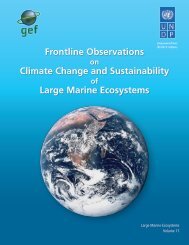Climate change futures: health, ecological and economic dimensions
Climate change futures: health, ecological and economic dimensions
Climate change futures: health, ecological and economic dimensions
Create successful ePaper yourself
Turn your PDF publications into a flip-book with our unique Google optimized e-Paper software.
76 | NATURAL AND MANAGED SYSTEMSCASE STUDIESTHE FUTURECCF-I: ESCALATING IMPACTS<strong>Climate</strong> <strong>change</strong> will affect agriculture around theglobe. A changing climate will alter the hydrologicalregime, the timing of seasons, the arrival of pollinators<strong>and</strong> the prevalence, extent, <strong>and</strong> type of crop diseases<strong>and</strong> pests. Globalization <strong>and</strong> intensification techniquesmay also contribute to new configurations of plant-pestrelationships that affect cultivated <strong>and</strong> wild plants.A warming of 1°C is estimated to decrease wheat, rice<strong>and</strong> corn yields by 10% (Brown 2002). Warming ofseveral °C or more is projected to alter production significantly<strong>and</strong> increase food prices globally, increasing therisk of hunger in vulnerable populations (Houghton et al.2001). Particularly large crop losses become more likelywhen extreme weather events produce favorable conditionsfor pest outbreaks.<strong>Climate</strong> <strong>change</strong> can lead to the resurgence of preexistingpathogens or can provide the conditions forintroduced pathogens to thrive. Milder winters <strong>and</strong>higher overall temperatures will facilitate winter survivalof plant pathogens <strong>and</strong> invasive species, <strong>and</strong> acceleratevector <strong>and</strong> pathogen life cycles (foliar fungi, bacteria,viruses) (Anderson et al. 2004).While global average water vapor concentration <strong>and</strong>precipitation are increasing, irrigation requirements areprojected to increase in some agricultural regions <strong>and</strong>larger year-to-year variations in precipitation are verylikely over most areas (Houghton et al. 2001). These<strong>change</strong>s will likely lead to increased outbreaks of foliarfungal diseases, such as soybean rust. Warming <strong>and</strong>increased precipitation <strong>and</strong> accompanying diseaseswould increase the use (<strong>and</strong> costs) of pesticides for certaincrops, such as corn, cotton, potatoes, soybeans<strong>and</strong> wheat (Chen <strong>and</strong> McCarl 2001).Models for cereal crops indicate that, in some temperateareas, potential yields increase with small temperatureincreases, but decrease with large temperaturerises. In most tropical <strong>and</strong> subtropical regions, however,potential yields are projected to decrease under all projectedtemperature <strong>change</strong>s, especially for dryl<strong>and</strong>/rainfedregions where rainfall decreases substantially.The impacts of climate <strong>change</strong>, therefore, will fall disproportionatelyupon developing countries <strong>and</strong> on the poorwithin all countries, exacerbating inequities in <strong>health</strong> status<strong>and</strong> access to food, clean water <strong>and</strong> other basicresources. Shortages in food supply could generate distortionsin international trade at regional <strong>and</strong> global levels,<strong>and</strong> disparities <strong>and</strong> disputes could become morepronounced over time (Houghton et al. 2001).CCF-II: SURPRISE IMPACTSThe current trajectory for warming <strong>and</strong> more violent<strong>and</strong> unpredictable weather could have catastrophiceffects on agricultural yields in the tropics, subtropics<strong>and</strong> temperate zones. Disease outbreaks could take anenormous toll in developing nations, <strong>and</strong> overuse ofpesticides could breed widespread resistance amongpests <strong>and</strong> the virtual elimination of protective predators.With pests currently causing yield losses over 40%worldwide (Altaman 1993), losses could climb steeplyto include the majority of food crops, especially fortropical crops such as sugarcane, for which currentannual losses often exceed 50% under today’s conditions.With production of the eight most vital foods onthe order of US $300 billion annually, <strong>and</strong> over 50%growing <strong>and</strong> stored grains now lost to pests,pathogens <strong>and</strong> weeds, more warming, weatherextremes <strong>and</strong> pests could drive losses in particularlydevastating years well over US $150 billion perannum. Multi-regional food shortages could lead topolitical instability.SPECIFIC RECOMMENDATIONSEarly warning systems of extreme events can aid in thea) selection of seeds, b) timing of planting, <strong>and</strong> c) planningfor petrol, petrochemical <strong>and</strong> fertilizer requirements.Figure 2.30 Healthy Corn FieldsImage: Shaefer Elvira/Dreamstime


